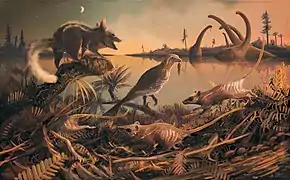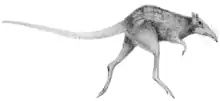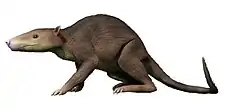Durlstotherium
Durlstotherium is an extinct genus of mammal from the Early Cretaceous. It contains a single species, Durlstotherium newmani. The type specimen was found in Durlston Bay, Dorset, after which the genus was named.[1] D. newmani was named after a British pub landlord, Charlie Newman.[2] Durlstotherium and two of its contemporaries, Tribactonodon and Durlstodon, had tribosphenidan (three-cusped) molars, which are an advanced characteristic among eutherian mammals and suggest that the group emerged earlier than the Early Cretaceous.[1]

Artist's impression of Durlstotherium (right and center) and Durlstodon (left)
| Durlstotherium Temporal range: Middle Berriasian | |
|---|---|
 | |
| Molars of Durlstotherium newmani (A) and Durlstodon ensomi (B) | |
| Scientific classification | |
| Domain: | Eukaryota |
| Kingdom: | Animalia |
| Phylum: | Chordata |
| Class: | Mammalia |
| Clade: | Eutheria |
| Genus: | †Durlstotherium Sweetman et al., 2017 |
| Type species | |
| †Durlstotherium newmani Sweetman et al., 2017 | |
References
- Sweetman, S.C.; Smith, G.; Martill, D.M. (2017). "Highly derived eutherian mammals from the earliest Cretaceous of southern Britain". Acta Palaeontologica Polonica. 62 (4): 657–665. doi:10.4202/app.00408.2017.
- Quach, Katyanna (November 8, 2017). "Our oldest mammalian ancestor named after British pub landlord". The Register.
This article is issued from Wikipedia. The text is licensed under Creative Commons - Attribution - Sharealike. Additional terms may apply for the media files.


